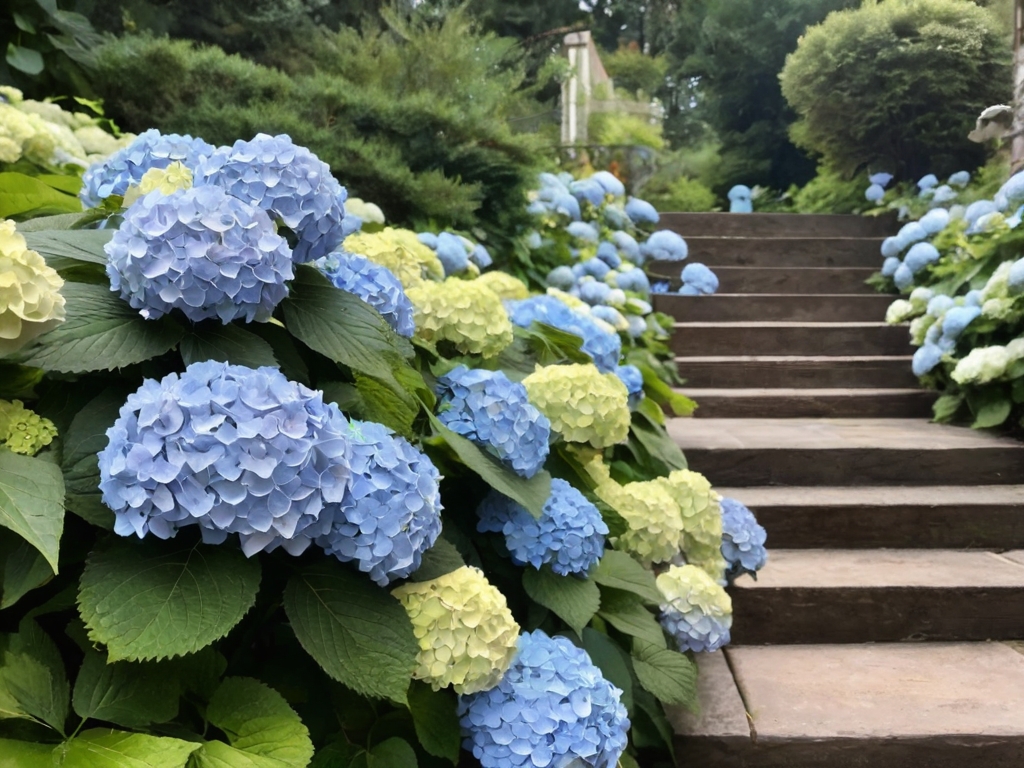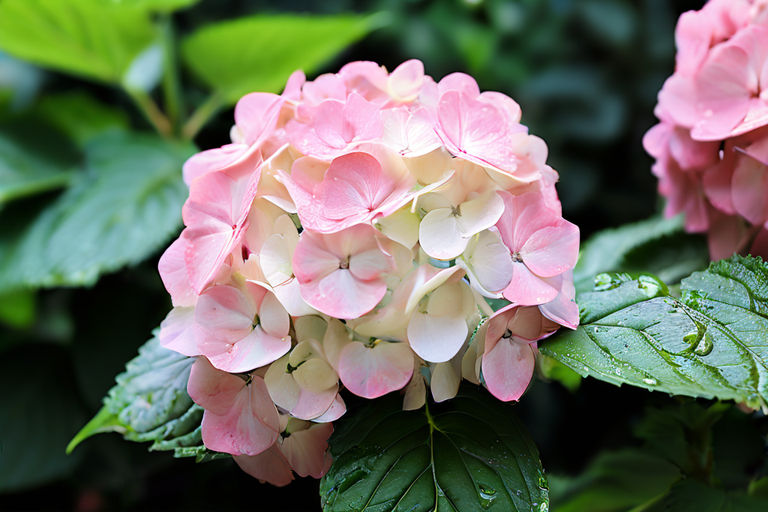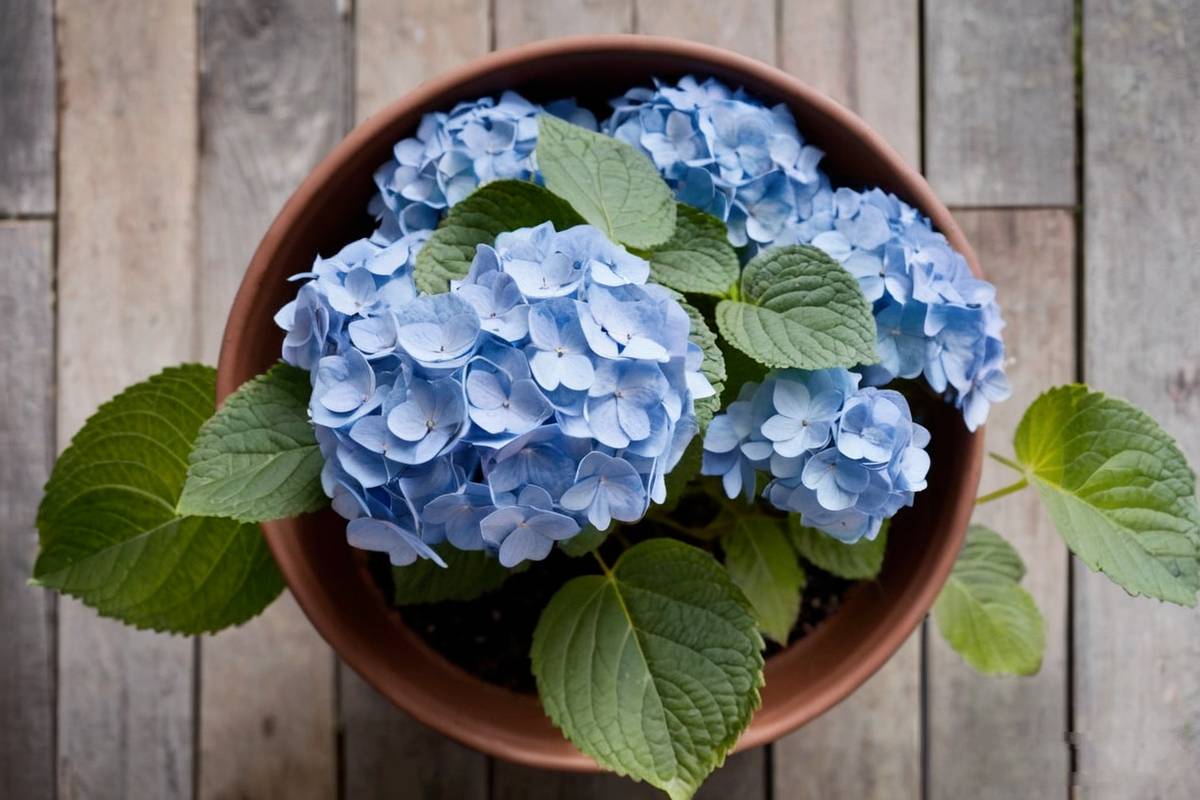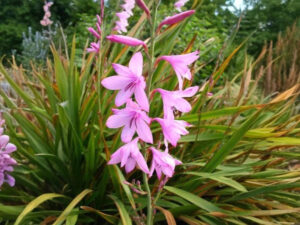
Hydrangeas come in a variety of colors, such as vibrant pinks, blues, and purples. Their large and showy blossoms make them a delightful addition to any garden or indoor space.
- Pros:
- Beautiful, showy blooms
- Versatile plant for both indoor and outdoor settings
- Adds a touch of elegance to any space
- Attracts butterflies and beneficial insects
- Available in a variety of colors to suit different preferences
- Cons:
- Require regular watering and attention to soil moisture levels
- Can be susceptible to certain pests and diseases
- Some varieties may require pruning to maintain optimal growth
In this article
- 1 Appearance of Hydrangeas
- 2 Light Requirements for Hydrangeas
- 3 Watering Hydrangeas
- 4 Fertilizing Hydrangeas
- 5 Potting Hydrangeas
- 6 Propagation of Hydrangeas
- 7 Growth and Development of Hydrangeas
- 8 Managing Pests and Diseases for Hydrangeas
- 9 Complimentary Plants with your Hydrangeas
- 10 Plants that should not be planted with Hydrangeas
Appearance of Hydrangeas

The leaves of Hydrangea plants are typically large and glossy, with an attractive shade of green. The flowers are the stars of the show, coming in an array of shapes and sizes. They can be round, cone-shaped, or even resemble lacey blooms.
Hydrangeas are known for their ability to change color based on soil acidity, so you may even find different colored blooms on the same plant.
- Leaf shape and size: Large, glossy leaves that add an elegant touch.
- Flower variety: Round, cone-shaped, or lacey blooms in various colors.
- Beginner-friendly: Hydrangeas are generally considered beginner-friendly, making them suitable for novice gardeners.
- Water requirements: Hydrangeas have moderate water requirements and prefer consistently moist soil.
- Sunlight requirements: While Hydrangeas thrive in bright indirect light, they can also tolerate some shade.
- Pot size required: Choose a pot that allows for root growth, ensuring adequate space for the plant to flourish.
Great for People who:
Hydrangeas are perfect for individuals seeking to infuse their surroundings with a touch of timeless elegance and vibrant colors. Whether you’re a gardening enthusiast looking to enhance your outdoor space or a homeowner aiming to bring a touch of nature indoors, hydrangeas offer versatility and beauty that can uplift any environment
Great for these Spaces:

Hydrangeas thrive in spaces that receive ample natural light, making them ideal for rooms with large windows or areas with higher ceilings. Their lush foliage and stunning blooms can brighten up living rooms, dining areas, or even office spaces, adding a refreshing and picturesque element to any setting.
Caring for Hydrangeas
When it comes to care, I’ve learned that Hydrangeas require a moderate level of attention. They appreciate regular watering to keep the soil consistently moist, but it’s important not to overwater them. Maintain a well-draining soil mix to prevent waterlogging, as Hydrangeas are susceptible to root rot. Additionally, pruning Hydrangeas at the right time can help promote healthy growth and abundant blooms.
Toxicity Level of Hydrangeas
Hydrangeas contain elements that can be toxic to both humans and pets if ingested. While they may not be lethal, consuming significant amounts of Hydrangea leaves or flowers can lead to discomfort, nausea, or vomiting. It’s crucial to keep them out of the reach of curious children and pets to avoid any potential issues.
Light Requirements for Hydrangeas

In terms of light requirements, Hydrangeas prefer ample bright indirect light. They thrive in locations with a good balance of sunlight and shade.
However, direct sunlight for extended periods can scorch their leaves, so it’s essential to provide some protection or move them to a shadier spot during the hottest part of the day.
Here’s an overview of the light conditions and their effect on Hydrangeas:
| Light Conditions | Effect on Hydrangeas |
|---|---|
| Bright Indirect Light | Promotes optimal growth |
| Low Light | Tolerated, but may reduce blooms |
| Direct Sunlight | Can cause leaf scorching |
Watering Hydrangeas
When it comes to watering Hydrangeas, I found that maintaining consistent moisture is key. The soil should be kept moist but not soggy. Overwatering can lead to root rot, while underwatering may cause the plant to wilt and suffer. To ensure proper hydration, follow these watering guidelines:
- Check the soil moisture regularly by inserting your finger about an inch deep into the soil. If it feels dry, it’s time to water.
- Water thoroughly, allowing the water to penetrate the entire root ball.
- Avoid standing water by ensuring proper drainage, as Hydrangeas are sensitive to waterlogged soil.
- Adjust the watering frequency based on environmental conditions. During hot and dry periods, you may need to water more frequently.
Fertilizing Hydrangeas

Miracle-Gro Performance Organics Blooms Plant Nutrition Granules
To keep Hydrangeas healthy and encourage robust blooms, proper fertilization is essential. I quickly learned that it’s crucial to use the right fertilizer and apply it at the correct times. Here’s a guide to fertilizing Hydrangeas:
- Spring (March-May): Apply a balanced slow-release fertilizer to promote overall plant health. Follow the recommended dosage instructions on the package.
- Summer (June-August): If your Hydrangeas need an extra boost, you can apply a water-soluble fertilizer once a month. Make sure to dilute it according to the manufacturer’s instructions.
- Fall (September-November): Reduce or stop fertilization during this time to allow the plant to prepare for dormancy.
- Winter (December-February): No fertilization is necessary during the dormant period.
Potting Hydrangeas

When potting Hydrangeas, it’s important to provide them with enough space to grow and thrive. Here are some guidelines to follow:
- Choose a pot with drainage holes to prevent waterlogging.
- Select a well-draining potting mix that retains moisture without becoming overly compacted.
- Ensure the pot is wide enough to accommodate the root ball, allowing room for future growth.
- Repot the plant every few years to prevent root crowding and maintain optimal health.
Propagation of Hydrangeas
Propagating Hydrangeas can be an exciting and rewarding experience for plant enthusiasts. From my personal experience, I’ve had success with propagating Hydrangeas through stem cuttings. Here’s a step-by-step guide to help you get started:
- Select a healthy stem from the parent plant and cut it just below a leaf node.
- Remove the lower leaves from the cutting, leaving only a few at the top.
- Dip the cut end into a rooting hormone to encourage root development.
- Plant the cutting in a well-draining potting mix, ensuring good soil contact.
- Place the pot in a warm and humid environment, providing indirect light.
- Keep the soil moist but not waterlogged, misting the cutting occasionally.
- After a few weeks, the cutting should develop roots. You can then transplant it into a larger pot or directly into the garden.
Growth and Development of Hydrangeas
Hydrangeas thrive in specific light, humidity, and temperature conditions. For optimal growth, provide them with bright indirect light and moderate humidity levels. In the United States, the best time to grow Hydrangeas is typically during the spring and summer months. Additionally, regular cleaning of the leaves helps remove dust and maintain a healthy plant environment.
Managing Pests and Diseases for Hydrangeas
Hydrangeas can be vulnerable to certain pests and diseases. Common pests include aphids, spider mites, and whiteflies. Regular inspection and prompt action are crucial in preventing infestations. Keeping the foliage clean and well-maintained helps deter pests.
Additionally, powdery mildew and leaf spot are potential fungal diseases that may affect Hydrangeas. Adequate spacing between plants and proper airflow can help reduce the risk of fungal infections.
Complimentary Plants with your Hydrangeas
Pairing hydrangeas with plants like Hostas and Japanese Maples can indeed create a visually appealing garden display.
- Hostas: These leafy perennials offer contrasting foliage textures and colors.
- Japanese Maples: The distinctive leaf shapes and vibrant colors of Japanese Maples create an eye-catching combination with Hydrangeas.
Plants that should not be planted with Hydrangeas
There are certain plants that should not be paired with hydrangeas to ensure optimal growth and health of the hydrangea bushes. Lavender plants, royal ferns, oak trees, asparagus, and conifers like thujas, junipers, pines, and dwarf pines are among the plants that are not recommended to be planted close to hydrangeas.
- Lavender plants prefer lots of sun and dry conditions, which are contrary to the needs of hydrangeas.
- Royal ferns thrive in wet soil, making them incompatible with hydrangeas that require well-draining soil.
- Oak trees have dense canopies and thick roots that can hinder the growth of hydrangeas.
- Asparagus and conifers have specific soil and light requirements that may not align with those of hydrangea.
Frequently asked questions
Can I change the color of Hydrangea blooms?
Yes, you can influence the color of Hydrangea blooms by manipulating the soil acidity. Adding aluminum sulfate to increase acidity leads to blue blooms, while reducing acidity (increasing alkalinity) results in pink blooms.
How often should I prune my Hydrangeas?
The best time to prune Hydrangeas varies based on the specific variety. However, most Hydrangeas benefit from pruning in late winter or early spring before new growth appears. Remove any dead or damaged wood and shape the plant as desired.
Can I grow Hydrangeas in containers?
Yes. Hydrangeas can thrive in containers as long as you choose a suitable pot, provide proper drainage, and use a well-draining potting mix. Just ensure the container is large enough to accommodate its growth and follow the care guidelines mentioned earlier.
Why is my Hydrangea not blooming?
Several factors can contribute to a Hydrangea not blooming, including insufficient light, improper pruning, or immature plants. Check that your Hydrangea is receiving adequate sunlight, follow the correct pruning techniques, and give younger plants time to establish themselves before expecting blooms.
Can I grow Hydrangeas from seeds?
While it is possible to grow Hydrangeas from seeds, it requires additional time, effort, and patience compared to other propagation methods. It’s often easier and more reliable to propagate Hydrangeas through stem cuttings or by dividing mature plants.
Hydrangeas are enchanting plants that add a touch of elegance and beauty to any space. With their stunning blooms, they have the power to transform gardens, balconies, and indoor settings into vibrant sanctuaries.







